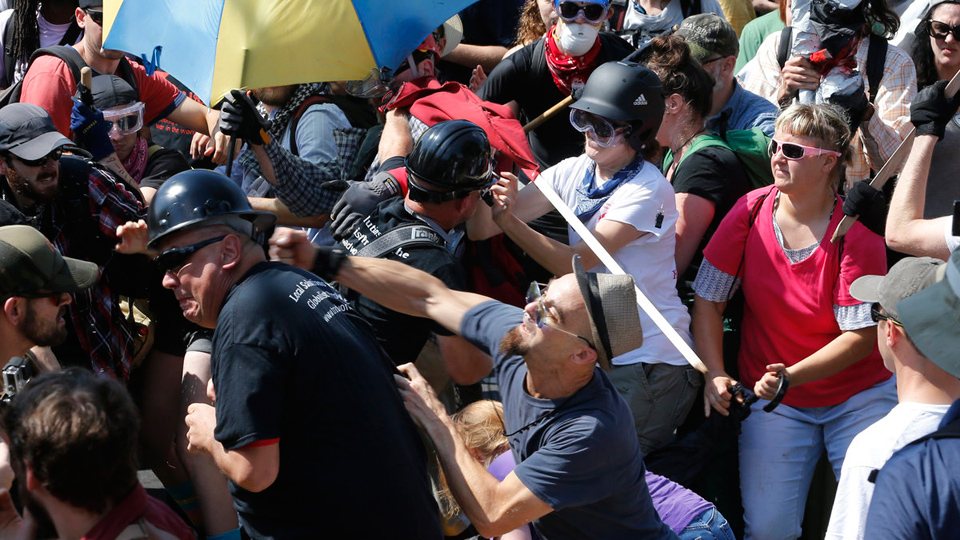
In the aftermath of Charlottesville, the question of how to respond to white supremacists and the fascist danger they pose is being discussed all around the country. People are debating the best tactic for dealing with these forces: direct confrontation, ignoring them, demonstrations, or what?
At the risk of grossly oversimplifying the issue, the best tactic can be summed up in one word: UNITY. Building the broadest possible unity to isolate the fascist element and push them back to the fringes is the key question. This is particularly important in the wake of Trump’s giving license and comfort to these elements with his remarks after Charlottesville and the subsequent pardoning of Sheriff Joe Arpaio.
How do you build unity in this fight?
One of the first things that we should keep in mind is the necessity of avoiding provocations. At this stage, the goal of the organized fascist fringe is to stage provocative actions with the aim of eliciting an in-kind response from the democratic and working-class movement. They hope the violence of their rhetoric and actions will be met by violence from our side. Because they often have implicit support from police and other sections of the justice system, the racists bet on regressive measures being mostly directed at the left in response. Therefore, not letting ourselves be provoked is very important.
Second, building unity means building the movement on the broadest possible foundation: that means rejecting any attempt to frame the anti-fascist struggle as simply one of right vs. left. This struggle has to be understood and approached tactically as one of the fascist-minded and racist fringe against the broad majority. As we formulate demands and slogans, we have to keep this framing in mind.
It’s likely that challenges against the movement’s breadth may arise from the left. Some may ask, “You want to make the coalition broad, but won’t that dilute the issue and open it up to being sidetracked?” The answer is yes. That’s always a danger, but the larger danger lies in not working actively to narrow the right’s possible base of support.
Successfully winnowing down the right’s support means engaging people who could be influenced by its views. This effort has to aim at finding common ground on issues like health care, jobs, immigration reform, the Fight for $15, etc. It is here that working-class unity can be forged which can lay the basis down the road for even broader united action on other issues.
Third, tactical flexibility and creativity must be employed. All of the tools in the toolbox should be used in the course of struggle: boycotts, sit-ins, occupations, demonstrations, strikes, picket lines, petition drives, disruptions—you name it. When it comes to the issues we care about, it should not be business as usual, particularly when it comes to taking on the 1 percent.
Here, we should be careful to also include social media: articles, memes, videos, podcasts, etc. What we Marxists call the “battle of ideas” is one of the main areas of struggle.
Whatever the arena of engagement, thought should be given to the question of who and where protests are aimed at. The focus should be the ruling class wherever and whenever possible. One aspect of the genius of Occupy Wall Street was that it took aim at Wall Street itself. Holding rallies, demos, and sit-ins at corporate headquarters and in public officials’ offices is the way to go – the bigger and more militant, the better.
In confronting the fascist right, it is necessary to make a distinction between the fringe that’s actually organized into groups and the wider audience whom they influence but that doesn’t participate directly in their actions, at least not yet. There are those who have banded together in militias and other outfits, and then there are others who are unorganized. The latter might be described as the crowd holding the “I’m not a racist, but…” type of view.
Tactics employed against the first organized group should be very different from those targeting the unorganized elements who may be open to sympathizing with them. Organizations like the Southern Poverty Law Center rely on legal cases to hamper the efforts of the organized groups and conduct exposés of their individual leaders.
Can Trump voters be part of the coalition?
With regard to the second and much larger group of the unaffiliated, who may be moved and organized to take racist group actions, (e.g. voting for Trump), the key issue is involving them in struggle around the bread-and-butter issues that affect them: health care, jobs, the environment, taxes, etc. And it can be done.
I sought out the opinion of an old civil rights worker, and he made this point strongly. He recalled a few instances in the Deep South where such coalition-building efforts were undertaken. Some individuals who became involved were even Ku Kluxers. He said, “I know for a fact that they were.” And yet, they were moved by self interest to take better positions. Better positions in these cases will not necessarily be anti-racist ones, of course. Oftentimes, the most that can be hoped for is to neutralize the worst expressions, resulting in what might be described as a non-racist posture.
But what about the first group, those who are organized? What approach should be taken to dealing with them? There is a trend today that argues for direct confrontation. Such an approach can be seen as brave, and we might admire it. However, history suggests it’s not the way to go.
At the end of the day, in case after case, such tactics have resulted in generalized attacks on the left. The history of the Black Panther Party is a case in point. Brave! Admirable! Such words can of course be used to describe many of its members. But confronting the police opened them up to attack by the most powerful forces in the country. We also have to consider that meeting violence with violence (whether real or perceived), is then used as an excuse for greater repression against not only the left, but democracy in general.
But isn’t the above just wishy-washy liberalism that didn’t work before? One person sent in a letter to People’s World that said just that. “You can’t reason with these people and therefore you have to take another tact,” the reader argued. There’s more than an element of truth here, but one must take issue with the conclusion.
The civil rights movement did work
First, it’s not true that the civil rights movement didn’t work. The sit-ins, boycotts, marches, mass jailings, and other tactics employed by Martin Luther King Jr., the SCLC, SNCC and others did work—and they worked magnificently! Consider it: the racist element—which enjoyed broad influence—was largely isolated, and as a result, de jure segregation was defeated. Voting rights were won, and the number of Black elected officials soared to several thousand from almost zero.
This was no small achievement. After 200 years of struggle, including the Revolution of 1776, the Civil War, and mass working class and democratic movements, the bourgeois democratic revolution was finally won in the United States in the 1960s with the passing of the Civil Rights acts.
As a result of the civil rights movement, the powers that be, in both North and South, were compelled to act. The tactics of that movement, while non-violent and peaceful, were muscular. They unleashed social and class forces that acted almost as a force of nature.
In this regard, the tactics suggested here aren’t mild-mannered. They too are designed to unleash powerful social forces. Certainly, with some of these racist and fascist elements, force and compulsion may indeed be necessary. There is, however, such a thing as non-violent force and non-violent compulsion. A strike, for example, is by definition an act of force. It forces an end to production with all its many and profound ramifications.
So too with certain types of sit-in and boycotts. We are forcing an end to business as usual and simultaneously hitting them where it hurts—in their pocketbooks—which at the end of the day is the only language big business really understands.
In order to meet history’s challenge—defeating capitalism’s ugliest and most extreme expression—we must draw history’s lessons. The united front strategy is the way forward, even as we learn from the mistakes and weaknesses of past practice. Early signs are that this fight is winnable. The anti-Trump resistance movement has scored some important wins, the trade unions are beginning more and more to take the field of battle, and the organized left is growing—a factor which is crucial to the movement’s success.
Good tactics will help insure this trend continues; bad ones will result in our isolation and defeat. Those are the stakes.












Comments